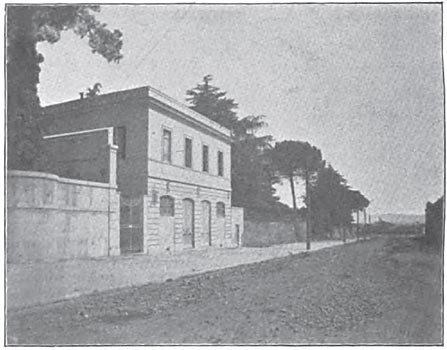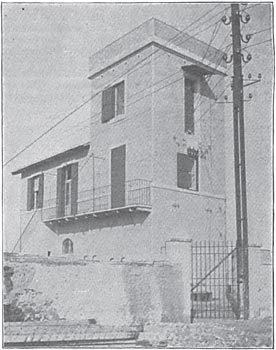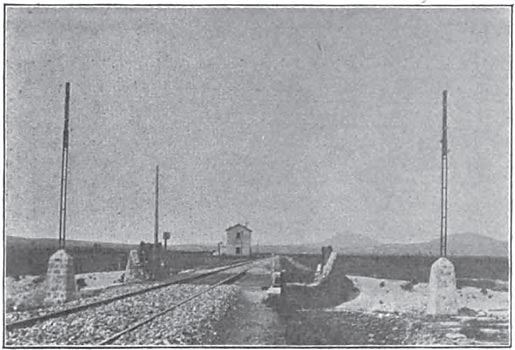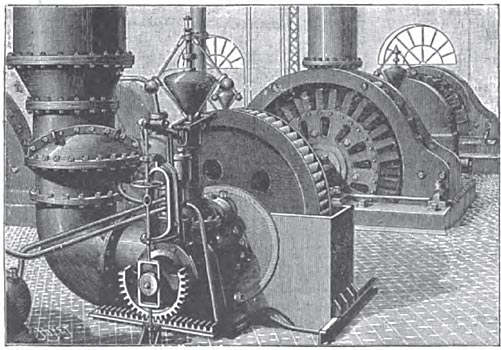[Trade Journal]
Publication: The Electrical Engineer
New York, NY, United States
vol. 17, no. 315, p. 424-425, col. 1-2
ELECTRICAL TRANSMISSION OF POWER IN ITALY.
AT the present time when high tension electrical power transmission is a matter of so much discussion and when the question of its commercial practicability is interesting the engineers and financiers of this country so deeply, it is especially interesting to direct attention again to one of the first successful plants of this nature, now in satisfactory operation in Italy, between Tivoli and me. Our present article deals more particularly with the important detail of the pole line. As our readers may remember, the generating station installed by Ganz & Co., of Budapest, is situated at the Falls of Tivoli, about eighteen miles from Rome, whence current with a potential of 5,000 volts is carried to the city.(1) In the station are three alternators with exciters arranged as shown in the plan, and driven by nine turbines, in the following manner. These are three complete units each consisting of a generator, driven by two turbines at 330 h. p. each and an exciter driven by a smaller turbine of 50 h. p. The alternators give 42 amperes at 5,100 volts, run at a speed of 170 revolutions a minute, and are coupled in parallel.
| |||
| Bridge Across the River Arriene for Line Inspection and Repair. |
| |||
| Transformer Station at the Porta Pia. |
| |||
| "Half Way House" for Electrical Measurements and Storage of Apparatus. |
The regulation proper is effected by means of two Blathy automatic rheostats maintaining the potential constant at Rome, a potential equalizer compensating for the losses in the line.
It is, however, of the line itself that we wish to speak more especially in the present instance, as affording an example of good workmanship that might with advantage be imitated in this country. To show this the more forcibly, we reproduce from our issue of May 2, an engraving of a tri-phase pole line extending from Baltic to Taftville, Connecticut, a distance of not quite four and one-half miles and place it side by side with a view of the eighteen mile Italian line. A critical comparison of the two is interesting. In the former the poles, as will be seen, are of wood, and, while substantial enough for several years of service, cannot compare with the light, yet solid and workmanlike appearance of the strong iron poles made of two T-beams 21 centimetres wide and firmly riveted together, planted in the deserted campagna, and quite capable of lasting until some other system is devised which shall put an end to their usefulness. They are placed about 100 feet apart and carry four twelve strand copper cables each 2.8 mm. in diameter, having a total weight of 100 tons and supported on heavy oil insulators, besides two silicon bronze telegraph or telephone wires 2 mm. in diameter.
| |||
| Tivoli-Roma Pole Line. |
| |||
| Baltic-Taftville Pole Line. A Comparison of Line Construction. |
About midway between Rome and Tivoli is the "halfway house" shown in one of our illustrations. This was designed to provide a convenient place for making electrical measurements and detecting faults in the line, and is fully equipped with the necessary apparatus for the purpose. Here also are stored extra poles, wires, insulators and tools, as well as the tackle and machinery necessary for erection and repair work. Every facility has been made for the latter all along the line and at no point is any wire, pole or insulator difficult of access. As an instance of this may be mentioned the plan adopted where the River Arriene is crossed, and where a lattice girder bridge has been built, spanning the river, for the sole purpose of carrying the pole line.
| |||
| Interior of Generating Station. |
The loss in the line is calculated at about 20 per cent., so that when the substation at the end of the route near the Porta Pia is reached the voltage has been reduced to approximately 4,000. Here it is transformed to 9,000 by 32 converters of 25 kilowatts each, which transmit current to a concentric cable system for general distribution throughout Rome, and also to the arc lighting circuits for street illumination. The transformers for the general distributing circuits have their secondaries so arranged that they may be coupled to produce 500, 1,000 1,500 or 2,000 volts, as circumstances dictate. Our illustrations are made from photographs sent to this country by Prof. Mengarini.
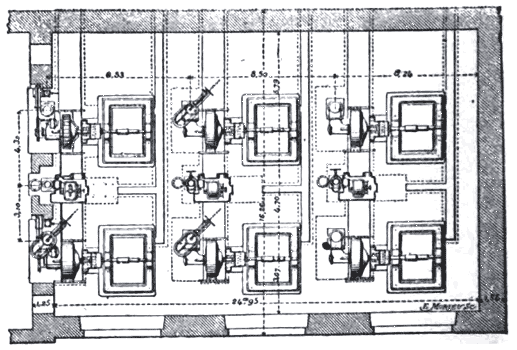 |
| Plan of Generating Station. |


